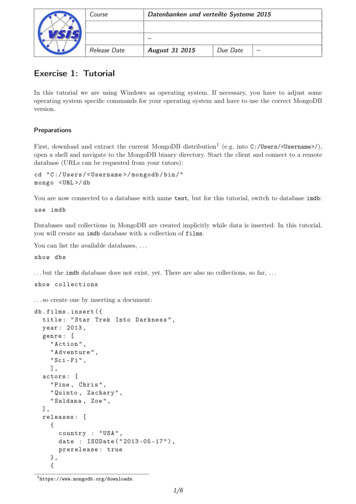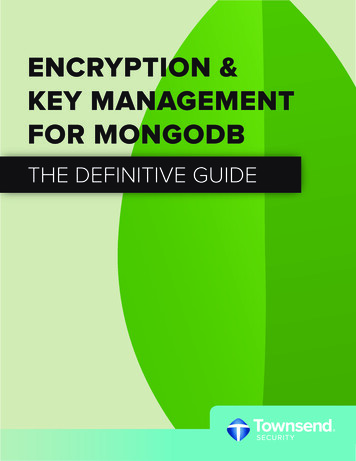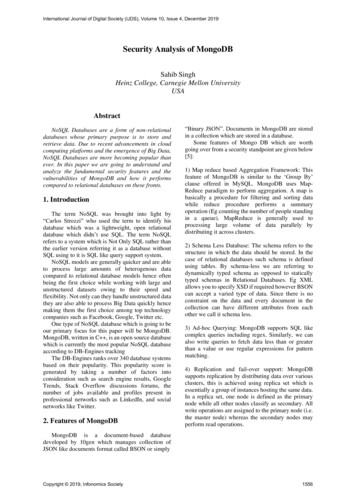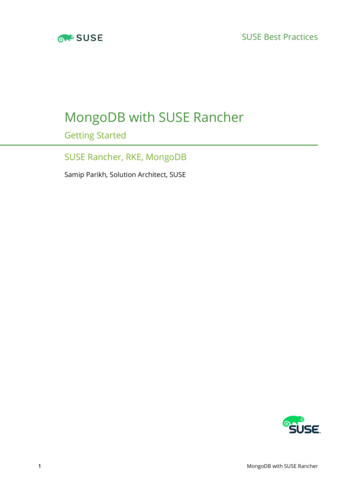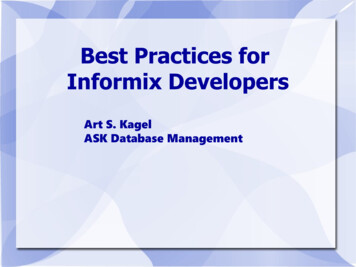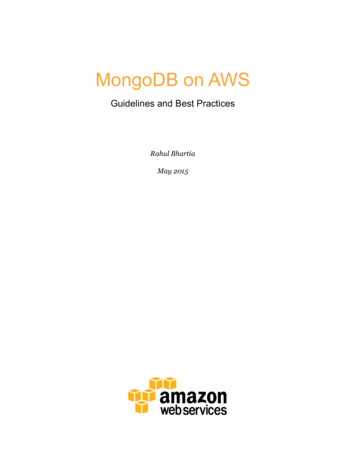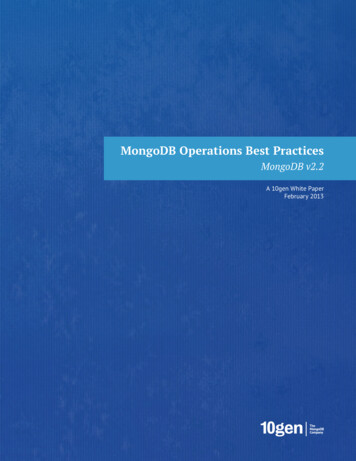
Transcription
MongoDB Operations Best PracticesMongoDB v2.2A 10gen White PaperFebruary 2013
Table of ContentsIntroduction.3III. Scaling a MongoDB Application . 15Roles and Responsibilities .4Horizontal Scaling with Shards . 15Data Architect .4Selecting a Shard Key . 16Database Administrator (DBA) .4Sharding Best Practices . 17System Administrator (sysadmin) .4Dynamic Data Balancing . 17Application Developer .4Sharding and Replica Sets . 18Network Administrator .4Geographic Distribution . 18I. Preparing for a MongoDBDeployment . 5IV. Disaster Recovery . 18Multi-Data Center Replication . 18Schema Design .5Document Size .5Data Lifecycle Management .6V. Capacity Planning . 19Indexing .7Monitoring Tools . 19Working Sets .9Things to Monitor . 21Backup and Restore . 18MongoDB Setup and Configuration . 10VI. Security . 2210Defense in Depth . 23Hardware . 11Access Control . 23Operating System and File SystemConfigurations for Linux . 12SSL . 23Data Migration .Data Encryption . 23Networking . 13Query Injection . 24Community Recommendations . 13II. High Availability . 13Journaling . 13Data Redundancy . 14Availability of Writes . 14Read Preferences . 162
MongoDB Operations Best PracticesMongoDB v2.2MongoDB is the open-source, document database that is popular among bothdevelopers and operations professionals given its agile and scalable approach.MongoDB is used in hundreds of production deployments by organizations rangingin size from emerging startups to Fortune 5 companies. This paper provides guidance on best practices for deploying and managing a MongoDB cluster. It assumesfamiliarity with the architecture of MongoDB and a basic understanding ofconcepts related to the deployment of enterprise software. For more informationon the architecture of MongoDB, please see the MongoDB Architecture Guide.Fundamentally MongoDB is a database and the concepts of the system, itsoperations, policies, and procedures should be familiar to users who have deployedand operated other database systems. While some aspects of MongoDB aredifferent from traditional relational database systems, skills and infrastructuredeveloped for other database systems are relevant to MongoDB and will help tomake deployments successful. Typically MongoDB users find that existing databaseadministrators, system administrators, and network administrators need minimaltraining to understand MongoDB. The concepts of a database, tuning, performance monitoring, data modeling, index optimization and other topics are veryrelevant to MongoDB. Because MongoDB is designed to be simple to administerand to deploy in large clustered environments, most users of MongoDB find thatwith minimal training an existing operations professional can become competentwith MongoDB, and that MongoDB expertise can be gained in a relatively shortperiod of time.This document discusses many best practices for operating and deploying aMongoDB system. The MongoDB community is vibrant and new techniques andlessons are shared every day.This document is subject to change. For the most up-to-date version of the document,please visit 10gen.com. For the most current and detailed information on specific topics,please see the online documentation at mongodb.org. Many links are provided throughout this document to help guide users to the appropriate resources online.3
I. Roles and ResponsibilitiesApplications deployed on MongoDB require careful planning and the coordination of a number of roles in an organization’s technical teams to ensure successful maintenance and operation. Organizations tend to find many of the same individuals and theirrespective roles for traditional technology deployments are appropriate for a MongoDB deployment: Data Architects, DatabaseAdministrators, System Administrators, Application Developers, and Network Administrators.In smaller organizations it is not uncommon to find these roles are provided by a small number of individuals, each potentiallyfulfilling multiple roles, whereas in larger companies it is more common for each role to be provided by an individual or teamdedicated to those tasks. For example, in a large investment bank there may be a very strong delineation between the functionalresponsibilities of a DBA and those of a system administrator.Data ArchitectWhile modeling data for MongoDB is typically simpler than modeling data for a relational database, there tend to be multipleoptions for a data model, and tradeoffs with each alternative regarding performance, resource utilization, ease of use, and otherareas. The data architect can carefully weigh these options with the development team to make informed decisions regardingthe design of the schema. Typically the data architect performs tasks that are more proactive in nature, whereas the databaseadministrator may perform tasks that are more reactive.Database Administrator (DBA)As with other database systems, many factors should be considered in designing a MongoDB system for a desired performanceSLA. The DBA should be involved early in the project regarding discussions of the data model, the types of queries that will beissued to the system, the query volume, the availability goals, the recovery goals, and the desired performance characteristics.System Administrator (sysadmin)Sysadmins typically perform a set of activities similar to what is required to manage other applications, including upgradingsoftware and hardware, managing storage, system monitoring, and data migration. MongoDB users have reported that theirsysadmins have had no trouble learning to deploy, manage and monitor MongoDB because no special skills are required.Application DeveloperThe application developer works with other members of the project team to ensure the requirements regarding functionality,deployment, security, and availability are clearly understood. The application itself is written in a language such as Java, C#, orRuby, data will be stored, updated, and queried in MongoDB, and language-specific drivers are used to communicate betweenMongoDB and the application. The application developer works with the data architect to define and evolve the data modeland to define the query patterns that should be optimized. The application developer works with the database administrator,sysadmin and network administrator to define the deployment and availability requirements of the application.Network AdministratorA MongoDB deployment typically involves multiple servers distributed across multiple data centers. Network resources are acritical component of a MongoDB system. While MongoDB does not require any unusual configurations or resources as comparedto other database systems, the network administrator should be consulted to ensure the appropriate policies, procedures,configurations, capacity, and security settings are implemented for the project.4
II. Preparing for a MongoDB DeploymentSchema DesignDevelopers and data architects should work together to develop the right data model, and they should invest time in thisexercise early in the project. The application should drive the data model, updates, and queries of your MongoDB system.Given MongoDB’s dynamic schema, developers and data architects can continue to iterate on the data model throughout thedevelopment and deployment processes to optimize performance and storage efficiency.The topic of schema design is significant, and a full discussion is beyond the scope of this document. A number of resources areavailable online, including conference presentations from 10gen solutions architects and MongoDB users, as well as trainingprovided by 10gen. Briefly, some concepts to keep in mind:DOCUMENT MODELMongoDB stores data as documents in a binary representation called BSON. The BSON encoding extends the popular JSONrepresentation to include additional types such as int, long, and floating point. BSON documents contain one or more fields, andeach field contains a value of a specific data type, including arrays and binary data. It may be helpful to think of documents asroughly equivalent to rows in a relational database, and fields as roughly equivalent to columns. However, MongoDB documentstend to have all data for a given record in a single document, whereas in a relational database information for a given record isusually spread across rows in many tables. In other words, data in MongoDB tends to be more localized.DYNAMIC SCHEMAMongoDB documents can vary in structure. For example, documents that describe users might all contain the user id and thelast date they logged into the system, but only some of these documents might contain the user’s shipping address, and perhapssome of those contain multiple shipping addresses. MongoDB does not require that all documents conform to the same structure.Furthermore, there is no need to declare the structure of documents to the system – documents are self-describing.COLLECTIONSCollections are groupings of documents. Typically all documents in a collection have similar or related purposes for anapplication. It may be helpful to think of collections as being analogous to tables in a relational database.INDEXESMongoDB uses B-tree indexes to optimize queries. Indexes are defined in a collection on document fields. MongoDB includessupport for many indexes, including compound, geospatial, TTL, sparse, unique, and others. For more information see the sectionon indexes.TRANSACTIONSMongoDB guarantees atomic updates to data at the document level. It is not possible to update multiple documents in a singleatomic operation. Atomicity of updates may influence the schema for your application.SCHEMA ENFORCEMENTMongoDB does not enforce schemas. Schema enforcement should be performed by the application.For more information on schema design, please see Data Modeling Considerations for MongoDB in the MongoDB Documentation.Document SizeThe maximum BSON document size in MongoDB is 16MB. User should avoid certain application patterns that would allowdocuments to grow unbounded. For instance, applications should not typically update documents in a way that causes themto grow significantly after they have been created, as this can lead to inefficient use of storage. If the document size exceedsits allocated space, MongoDB will relocate the document on disk. This automatic process can be resource intensive and timeconsuming, and can unnecessarily slow down other operations in the database.For example, in a blogging application it would be difficult to estimate how many responses a blog post might receive from5
readers. Furthermore, it is typically the case that only a subset of comments is displayed to a user, such as the most recent orthe first 10 comments. Rather than modeling the post and user responses as a single document it would be better to modeleach response or groups of responses as a separate document with a reference to the blog post. Another example is productreviews on an e-commerce site. The product reviews should be modeled as individual documents that reference the product. Thisapproach would also allow the reviews to reference multiple versions of the product such as different sizes or colors.OPTIMIZING FOR DOCUMENT GROWTHMongoDB adaptively learns if the documents in a collection tend to grow in size and assigns a padding factor to provide sufficientspace for document growth. This factor can be viewed as the paddingFactor field in the output of the db. collection-name .stats() command. For example, a value of 1 indicates no padding factor, and a value of 1.5 indicates a padding factor of 50%.When a document is updated in MongoDB the data is updated in-place if there is sufficient space. If the size of the document isgreater than the allocated space, then the document may need to be re-written in a new location in order to provide sufficientspace. The process of moving documents and updating their associated indexes can be I/O-intensive and can unnecessarilyimpact performance.SPACE ALLOCATION TUNINGUsers who anticipate updates and document growth may consider two options with respect to padding. First, theusePowerOf2Sizes attribute can be set on a collection. This setting will configure MongoDB to round up allocation sizes tothe powers of 2 (e.g., 2, 4, 8, 16, 32, 64, etc). This setting tends to reduce the chances of increased disk I/O at the cost of someadditional storage usage. The second option is to manually pad the documents. If the application will add data to a documentin a predictable fashion, the fields can be created in the document before the values are known in order to allocate theappropriate amount of space during document creation. Padding will minimize the relocation of documents and thereby minimizeoverallocaiton.GRIDFSFor files larger than 16MB, MongoDB provides a convention called GridFS, which is implemented by all MongoDB drivers. GridFSautomatically divides large data into 256KB pieces called “chunks” and maintains the metadata for all chunks. GridFS allows forretrieval of individual chunks as well as entire documents. For example, an application could quickly jump to a specific timestampin a video. GridFS is frequently used to store large binary files such as images and videos in MongoDB.Data Lifecycle ManagementMongoDB provides features to facilitate the management of data lifecycles, including Time to Live, and capped collections.TIME TO LIVE (TTL)If documents in a collection should only persist for a pre-defined period of time, the TTL feature can be used to automaticallydelete documents of a certain age rather than scheduling a process to check the age of all documents and run a series ofdeletes. For example, if user sessions should only exist for one hour, the TTL can be set for 3600 seconds for a date field calledlastActivity that exists in documents used to track user sessions and their last interaction with the system. A backgroundthread will automatically check all these documents and delete those that have been idle for more than 3600 seconds. Anotherexample for TTL is a price quote that should automatically expire after a period of time.CAPPED COLLECTIONSIn some cases a rolling window of data should be maintained in the system based on data size. Capped collections are fixed-sizecollections that support high-throughput inserts and reads based on insertion order. A capped collection behaves like a circularbuffer: data is inserted into the collection, that insertion order is preserved, and when the total size reaches the threshold of thecapped collection, the oldest documents are deleted to make room for the newest documents. For example, store log informationfrom a high-volume system in a capped collection to quickly retrieve the most recent log entries without designing for storagemanagement.DROPPING A COLLECTIONIt is very efficient to drop a collection in MongoDB. If your data lifecycle management requires periodically deleting largevolumes of documents, it may be best to model those documents as a single collection. Dropping a collection is much moreefficient than removing all documents or a large subset of a collection, just as dropping a table is more efficient than deleting all6
the rows in a table in a relational database.IndexingLike most database management systems, indexes are a crucial mechanism for optimizing system performance in MongoDB. Andwhile indexes will improve the performance of some operations by one or more orders of magnitude, they have associated costsin the form of slower updates, disk usage, and memory usage. Users should always create indexes to support queries, but shouldtake care not to maintain indexes that the queries do not use. Each index incurs some cost for every insert and update operation:if the application does not use these indexes, then it can adversely affect the overall capacity of the database. This is particularlyimportant for deployments that have insert-heavy workloads.QUERY OPTIMIZATIONQueries are automatically optimized by MongoDB to make evaluation of the query as efficient as possible. Evaluation normallyincludes the selection of data based on predicates, and the sorting of data based on the sort criteria provided. GenerallyMongoDB makes use of one index in resolving a query. The query optimizer selects the best index to use by periodically runningalternate query plans and selecting the index with the lowest scan count for each query type. The results of this empirical testare stored as a cached query plan and periodically updated.MongoDB provides an explain plan capability that shows information about how a query was resolved, including: The number of documents returned. Which index was used. Whether the query was covered, meaning no documents needed to be read to return results. Whether an in-memory sort was performed, which indicates an index would be beneficial. The number of index entries scanned. How long the query took to resolve in milliseconds.Explain plan will show 0 milliseconds if the query was resolved in less than 1ms, which is not uncommon in well-tuned systems.When explain plan is called, prior cached query plans are abandoned, and the process of testing multiple indexes is evaluated toensure the best possible plan is used.If the application will always use indexes, MongoDB can be configured to throw an error if a query is issued that requires scanningthe entire collection.PROFILINGMongoDB provides a profiling capability called Database Profiler, which logs fine-grained information about database operations.The profiler can be enabled to log information for all events or only those events whose duration exceeds a configurablethreshold (whose default is 100ms). Profiling data is stored in a capped collection where it can easily be searched for interestingevents – it may be easier to query this collection than parsing the log files.PRIMARY AND SECONDARY INDEXESA unique, index is created for all documents by the id field. MongoDB will automatically create the id field and assign a uniquevalue, or the value can be specified when the document is inserted. All user-defined indexes are secondary indexes. Any field canbe used for a secondary index, including fields with arrays.COMPOUND INDEXESGenerally queries in MongoDB can only be optimized by one index at a time. It is therefore useful to create compound indexes forqueries that specify multiple predicates. For example, consider an application that stores data about customers. The applicationmay need to find customers based on last name, first name, and state of residence. With a compound index on last name, firstname, and state of residence, queries could efficiently locate people with all three of these values specified. An additionalbenefit of a compound index is that any leading field within the index can be used, so fewer indexes on single fields may7
be necessary: this compound index would also optimize queries looking for customers by last name.UNIQUE INDEXESBy specifying an index as unique, MongoDB will reject inserts of new documents or the update of a document with an existingvalue for the field for which the unique index has been created. By default all indexes are not unique. If a compound index isspecified as unique, the combination of values must be unique. If a document does not have a value specified for the field then anindex entry with a value of null will be created for the document. Only one document may have a null value for the field unlessthe sparse option is enabled for the index, in which case index entries are not made for documents that do not contain the field.ARRAY INDEXESFor fields that contain an array, each array alue is stored as a separate index entry. For example, documents that describe recipesmight include a field for ingredients. If there is an index on the ingredient field, each ingredient is indexed and queries on theingredient field can be optimized by this index. There is no special syntax required for creating array indexes – if the fieldcontains an array, it will be indexed as a array index.It is also possible to specify a compound array index. If the recipes also contained a field for the number of calories, a compoundindex on calories and ingredients could be created, and queries that specified a value for calories and ingredients would beoptimized with this index. For compound array indexes only one of the fields can be an array in each document.GEOSPATIAL INDEXESMongoDB provides geospatial indexes to optimize queries related to location within a two dimensional space, such as projectionsystems for the earth. Documents must have a field with a two-element array, such as latitude and longitude to be indexed with ageospatial index. These indexes allow MongoDB to optimize queries that request all documents closest to a specific point in thecoordinate system.SPARSE INDEXESSparse indexes only contain entries for documents that contain the specified field. Because the document data model ofMongoDB allows for flexibility in the data model from document to document, it is common for some fields to be present only ina subset of all documents. Sparse indexes allow for smaller, more efficient indexes when fields are not present in all documents.By default, the sparse option for indexes is false. Using a sparse index will sometime lead to incomplete results when performingindex-based operations such as filtering and sorting. By default, MongoDB will create null entries in the index for documents thatare missing the specified field.For more on indexes, see Indexing Overview in the MongoDB Documentation.INDEX CREATION OPTIONSIndexes and data are updated synchronously in MongoDB. The appropriate indexes should be determined as part of the schemadesign process prior to deploying the system.By default creating an index is a blocking operation in MongoDB. Because the creation of indexes can be time and resourceintensive, MongoDB provides an option for creating new indexes as a background operation. When the background option isenabled, the total time to create the indexes will be greater than if the indexes are created in the foreground, but it will still bepossible to use the database while creating indexes.PRODUCTION APPLICATION CHECKS FOR INDEXESMake sure that the application checks for the existence of all appropriate indexes on startup and that it terminates if indexes aremissing. Index creation should be performed by separate application code and during normal maintenance operations.INDEX MAINTENANCE OPERATIONSBackground index operations on a replica set primary become foreground index operations on replica set secondaries, which willblock all replication. Therefore the best approach to building indexes on replica sets is to:8
1. Restart the secondary replica in standalone mode.2. Build the indexes.3. Restart as a member of the replica set.4. Allow the secondary to catch up to the other members of the replica set.5. Proceed to step one with the next secondary.6. When all the indexes have been built on the secondaries, restart the primary in standalone mode. One of the secondaries will be elected as primary so the application can continue to function.7. Build the indexes on the original primary, then restart it as a member of the replica set.8. Issue a request for the original primary to resume its role as primary replica.See the MongoDB Documentation for Build Index on Replica Sets for a full set of procedures.INDEX LIMITATIONSThere are a few limitations to indexes that should be observed when deploying MongoDB: A collection cannot have more than 64 indexes. Index entries cannot exceed 1024 bytes. The name of an index must not exceed 128 characters (including its namespace). The optimizer generally uses one index at a time. Indexes consume disk space and memory. Use them as necessary. Indexes can impact update performance – an update must first locate the data to change, so an index will help in thisregard, but index maintenance itself has overhead and this work will slow update performance. In-memory sorting of data without an index is limited to 32MB. This operation is very CPU intensive, and in-memorysorts indicate an index should be created to optimize these queries.COMMON MISTAKES REGARDING INDEXESThe following tips may help to avoid some common mistakes regarding indexes: Creating multiple indexes in support of a single query: MongoDB will use a single index to optimize a query. If you needto specify multiple predicates, you need a compound index. For example, if there are two indexes, one on first name andanother on last name, queries that specify a constraint for both first and last names will only use one of the indexes, notboth. To optimize these queries, a compound index on last name and first name should be used. Compound indexes: Compound indexes are defined and ordered by field. So, if a compound index is defined for lastname, first name, and city, queries that specify last name or last name and first name will be able to use this index, butqueries that try to search based on city will not be able to benefit from this index. Low selectivity indexes: An index should radically reduce the set of possible documents to select from. For example, anindex on a field that indicates male/female is not as beneficial as an index on zip code, or even better, phone number. Regular expressions: Trailing wildcards work well, but leading wildcards do not because the indexes are ordered. Negation: Inequality queries are inefficient with respect to indexes.Working SetsMongoDB makes extensive use of RAM to speed up database operations. In MongoDB, all data is read and manipulated throughmemory-mapped files. Reading data from memory is measured in nanoseconds and reading data from disk is measured in milliseconds; reading from memory is approximately 100,000 times faster than reading data from disk. The set of data and indexesthat are accessed during normal operations is call the working set.9
It should be the goal of the deployment team that the working fits in RAM. It may be the case the working set represents a fraction of the entire database, such as in applications where data related to recent events or popular products is accessed mostcommonly.Page faults occur when MongoDB attempts to access data that has not been loaded in RAM. If there is free memory then theoperating system can locate the page on disk and load it into memory directly. However, if there is no free memory the operatingsystem must write a page that is in memory to disk and then read the requested page into memory. This process can be timeconsuming and will be significantly slower than accessing data that is already in memory.Some operations may inadvertently purge a large percentage of the working set from memory, which adversely affectsperformance. For example, a query that scans all documents in the database, where the database is larger than the RAM on theserver, will cause documents to be read into memory and the working set to be written out to disk. Other examples include somemaintenance operations such as compacting or repairing a database and rebuilding indexes.If your database working set size exceeds the available RAM of your system, consider increasing the RAM or adding additionalservers to the cluster and s
Network resources are a critical component of a MongoDB system. While MongoDB does not require any unusual configurations or resources as compared to other database systems, the network administrator should be consulted to ensure the appropriate policies, procedures, configurations, capacity, and security settings are implemented for the project.

